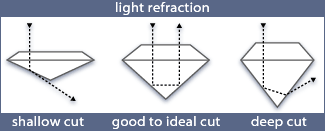|
|
|
Cut
Cut refers
to a diamond's proportions, which enhance a diamond's ability to refract light
as fire and brilliance. Many gemologists consider cut the most important diamond
characteristic because even if a diamond has perfect color and clarity, a
diamond with a poor cut will have only a dull sparkle.
Cut Determines Sparkle
The proportions of a diamond determines its ability to refract light,
so these measurements are also used to determine a cut grade. A diamond that is
cut too shallow or deep will lose light out the sides and bottom and will appear
dull, with little sparkle.

Because of this, the grade
of a diamond's cut is determined by the diamond's proportions: the height
compared to the depth, and the size of the table compared to the width.
Polish & Symmetry Affect Sparkle
The polish grade, which describes the smoothness of the diamond's finish,
and the symmetry grade,
|
|
which refers to alignment of
the facets, are called out separately on a diamond certificate, even though
their qualities are determined in the diamond cutting process. Poor polish will
dull a diamond's sparkle. If a diamond has poor symmetry, it will not refract
and reflect all the light that enters.
· Ideal cut:
Reflects nearly all light that enters the diamond. An exquisite, rare diamond.
· Very good
cut: Still of superior, rare quality, this diamond reflects nearly as much
light as the ideal cut, but for a considerably lower price.
· Good cut:
Reflects most light that enters and is often significantly less expensive than a
very good cut. An excellent value in a well-cut diamond.
· Fair cut:
A fair cut will sparkle, but will not be as brilliant as a higher grade of cut.
· Poor cut:
A lifeless-looking diamond. Poor-cut gemstones are not recommended by Amir Agha
for fine jewelry.
Amir Agha Diamond Cut
Amir Agha carries no diamonds with cut grades lower than fair, which
are too shallow or deep to refract an acceptable amount of sparkle.
What Cut Grade is the Best ?
· For a diamond
that earns the highest marks for its appearance even under a microscope, look
for cut grades of ideal or very good, and polish and symmetry grades of ideal or
excellent.
· For a diamond
that has no visible difference when compared with the naked eye to more
expensive cuts, choose a diamond with a cut grade of good, and polish and
symmetry grades of very good or good.
· For excellent
value with an ideal- or very-good cut diamond with ideal or excellent polish and
symmetry, consider less expensive grades of color and clarity — try a diamond
with G or H color and SI1–SI2 clarity.
At Glance :
Ideal Cut: Only
for round diamonds. Produces maximum amount of light reflection.
Very Good Cut: A better value than an ideal cut. Reflects
nearly all light.
Good Cut: An excellent value. Reflects back a large percentage
of light entered.
Fair Cut: Maximizes carat weight, not sparkle.
Poor Cut: Results in very little brilliance.